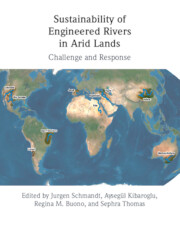Book contents
- Sustainability of Engineered Rivers in Arid Lands
- Sustainability of Engineered Rivers in Arid Lands
- Copyright page
- Dedication
- Contents
- Contributors
- Part I Introduction
- Part II Challenge
- Part III Engineered Rivers
- 7 The Nile River Basin
- 8 The Euphrates–Tigris River Basin
- 9 The Yellow River Basin
- 10 The Murray–Darling River Basin
- 11 The São Francisco River Basin
- 12 The Limarí River Basin
- 13 The Colorado River Basin
- 14 The Rio Grande / Río Bravo Basin
- 15 The Jucar River Basin
- Part IV Response
- Part V Conclusion
- Index
- References
11 - The São Francisco River Basin
from Part III - Engineered Rivers
Published online by Cambridge University Press: 16 September 2021
- Sustainability of Engineered Rivers in Arid Lands
- Sustainability of Engineered Rivers in Arid Lands
- Copyright page
- Dedication
- Contents
- Contributors
- Part I Introduction
- Part II Challenge
- Part III Engineered Rivers
- 7 The Nile River Basin
- 8 The Euphrates–Tigris River Basin
- 9 The Yellow River Basin
- 10 The Murray–Darling River Basin
- 11 The São Francisco River Basin
- 12 The Limarí River Basin
- 13 The Colorado River Basin
- 14 The Rio Grande / Río Bravo Basin
- 15 The Jucar River Basin
- Part IV Response
- Part V Conclusion
- Index
- References
Summary
The São Francisco river crosses some of the driest parts of the Brazilian Semi-arid Region and brings life to ecosystems and to millions of people. Droughts are a recurrent problem in the basin. Since the second part of the twentieth century, several dams, irrigation projects, and water and sanitation systems have been built, and these developments have impacted river conditions, such as stream flows, sedimentation, silting, and water quality. The development of the river, and its engineering solutions, have prioritized the hydroelectric and agricultural sectors. This has started to change with the new water law of 1997 and the creation of the National Water Agency (ANA) in 2000. This chapter reviews current water management and use in the basin as well as the scenarios, which indicate that, in the future, precipitation and stream flows may be reduced significantly due to climate change while water demand will increase due to population growth and development.
Keywords
- Type
- Chapter
- Information
- Sustainability of Engineered Rivers In Arid LandsChallenge and Response, pp. 132 - 151Publisher: Cambridge University PressPrint publication year: 2021

